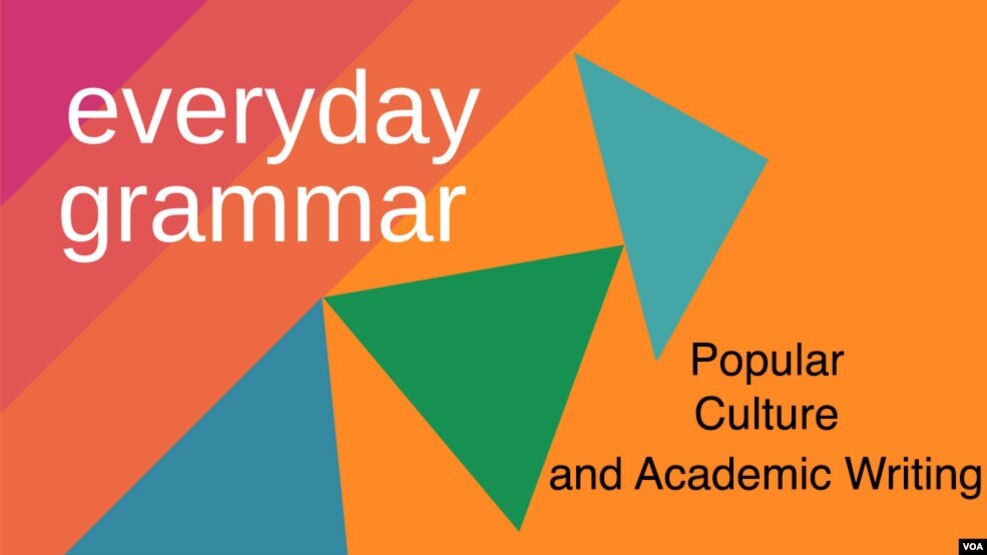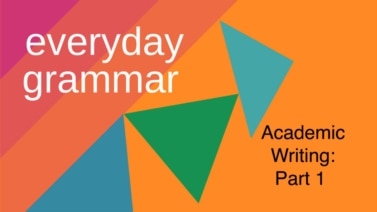
Popular culture can teach you about English grammar. You might be surprised to know that music and films can show you how to use difficult grammatical structures.
How so?
Consider the song “Capable of Anything” by the American singer Ben Folds.
“We’re told we are capable of anything But you don’t seem to think that you are Capable of anything”
In today’s report, we will explore one structure that you heard twice in the song - an adjective + preposition combination. The words “capable of” are an example of this type of structure.
Last week, we discussed common adjective and preposition combinations in everyday speech.
This week, we will explore such combinations in academic writing. Even though these structures are most often used in writing, we will give you fun examples of how speakers use them in songs and films, too.
But before we give you more specific examples of these combinations, we need to give you a few definitions.
What are adjective and preposition combinations?
Adjectives are words that describe nouns. They can come before a noun or after a non-action verb, sometimes called a linking verb.
These adjectives sometimes go with specific prepositions. Together, these adjectives and prepositions make combinations that have specific meanings.
When adjectives come before a noun, the adjective is almost never followed by a preposition. When adjectives come after a non-action verb, they may be followed by a preposition.
Here are two examples:
1: The students are happy.
2: The students are happy with the test results.
In the former sentence, the adjective happy describes the noun students. There is no preposition.
In the latter sentence, the adjective “happy” comes after the non-action verb BE. After the BE verb and the adjective “happy,” there is a preposition: with. “Happy with” is one example of an adjective and preposition combination.
Susan Conrad and Douglas Biber are language experts. They note that there are six common adjective and preposition combinations in academic writing.
We will not study all of these combinations today. Instead, we will study three of them: adjective + of, adjective + for and adjective + to.
Adj. + of
One common adjective and preposition combination is adjective + of.
Consider these lines from the 1961 film, Judgment at Nuremberg:
“My counsel says we were not aware of the extermination of the millions. He would give you the excuse we were only aware of the extermination of the hundreds. Does that make us any the less guilty?”
You will notice that the speaker used “aware of” twice. “Aware of” is a formal way of saying that someone knows about the existence or happening of a certain thing.
“Aware of” is one example of an adjective + of combination.
Other common examples include “independent of” and “capable of,” which you heard at the beginning of our report.
You might read these types of expressions in academic books about law, psychology, and so on.
Adj. + for
A second common adjective and preposition combination is adjective + for.
Once again, lines from the film Judgment at Nuremberg show you how speakers might use these structures:
“Are we now to find the American industrialists guilty? No, Your Honor. No! Germany alone is not guilty: The whole world is as responsible for Hitler’s Germany.”
You heard the words “responsible for” in the movie clip. “Responsible for” is one example of an adjective + for structure.
Other common examples include “essential for” and “necessary for.”
You might read these types of expressions in many types of academic books - philosophy, politics, and so on.
Adj. + to
Our final common adjective and preposition combination is adjective + to.
The words from the Beatles’ song The End use this structure.
“And in the end, the love you take is equal to the love you make.”
“Equal to” means that something is the same in number, amount, or quality. Other common examples include “identical to” and “similar to.”
You will often read these types of expressions in mathematics or physics books.
What can you do?
The next time you are reading a book or watching television in English, try to look for examples of adjective + a preposition. Does the writer or speaker use one of the structures we talked about today? Does the writer or speaker use different structures?
Learning these adjective + preposition combinations can be difficult. But if you work hard and practice, you will be capable of anything.
We are going to end our report with a homework assignment. Try to use “aware of,” “capable of,” “responsible for,” or “equal to” in sentences. Write your sentences in the comments section of our website.
I’m John Russell.
And I’m Jill Robbins.
John Russell wrote this story for Learning English. Caty Weaver was the editor.
Words in This Story
capable - adj. able to do something : having the qualities or abilities that are needed to do something -- + of
preposition - n. grammar : a word or group of words that is used with a noun, pronoun, or noun phrase to show direction, location, or time, or to introduce an object
academic - adj. of or relating to schools and education
specific - adj. special or particular
counsel - n. law : a lawyer who represents a person or group in a court of law
aware - adj. knowing that something (such as a situation, condition, or problem) exists
extermination - n. the act of destroying or killing (a group of animals, people, etc.)
formal - adj. suitable for serious or official speech and writing
essential - adj. extremely important and necessary


